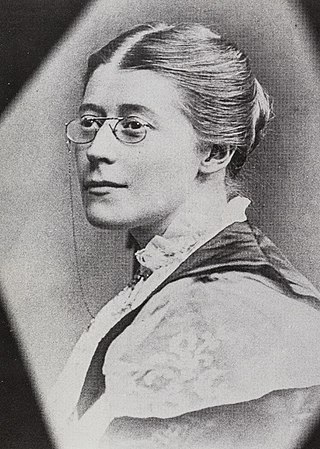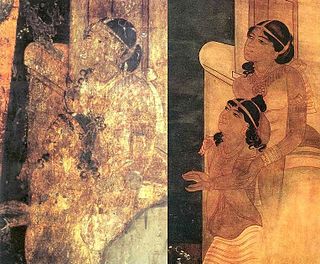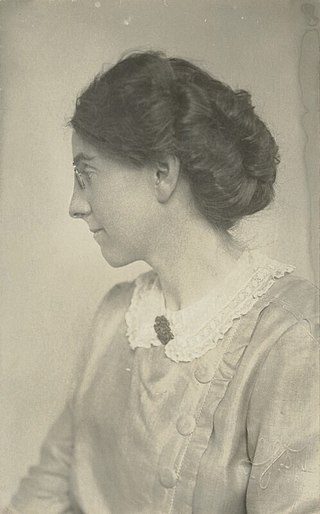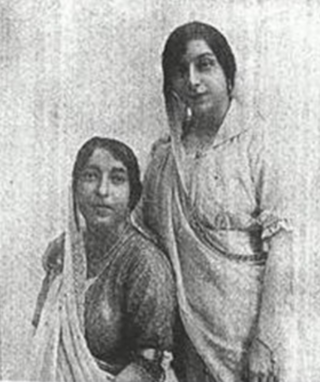Related Research Articles

Dame Millicent Garrett Fawcett was an English political activist and writer. She campaigned for women's suffrage by legal change and in 1897–1919 led Britain's largest women's rights association, the National Union of Women's Suffrage Societies (NUWSS), explaining, "I cannot say I became a suffragist. I always was one, from the time I was old enough to think at all about the principles of Representative Government." She tried to broaden women's chances of higher education, as a governor of Bedford College, London and co-founding Newnham College, Cambridge in 1875. In 2018, a century after the Representation of the People Act, she was the first woman honoured by a statue in Parliament Square.

Emmeline Pankhurst was a British political activist who organised the British suffragette movement and helped women win the right to vote. In 1999, Time named her as one of the 100 Most Important People of the 20th Century, stating that "she shaped an idea of objects for our time" and "shook society into a new pattern from which there could be no going back". She was widely criticised for her militant tactics, and historians disagree about their effectiveness, but her work is recognised as a crucial element in achieving women's suffrage in the United Kingdom.
Women's suffrage is the right of women to vote in elections. At the beginning of the 18th century, some people sought to change voting laws to allow women to vote. Liberal political parties would go on to grant women the right to vote, increasing the number of those parties' potential constituencies. National and international organizations formed to coordinate efforts towards women voting, especially the International Woman Suffrage Alliance.
he history of feminism comprises the narratives of the movements and ideologies which have aimed at equal rights for women. While feminists around the world have differed in causes, goals, and intentions depending on time, culture, and country, most Western feminist historians assert that all movements that work to obtain women's rights should be considered feminist movements, even when they did not apply the term to themselves. Some other historians limit the term "feminist" to the modern feminist movement and its progeny, and use the label "protofeminist" to describe earlier movements.

The Women's Social and Political Union (WSPU) was a women-only political movement and leading militant organisation campaigning for women's suffrage in the United Kingdom founded in 1903. Known from 1906 as the suffragettes, its membership and policies were tightly controlled by Emmeline Pankhurst and her daughters Christabel and Sylvia. Sylvia was eventually expelled.

Lydia Ernestine Becker was a leader in the early British suffrage movement, as well as an amateur scientist with interests in biology and astronomy. She established Manchester as a centre for the suffrage movement and with Richard Pankhurst she arranged for the first woman to vote in a British election and a court case was unsuccessfully brought to exploit the precedent. Becker is also remembered for founding and publishing the Women's Suffrage Journal between 1870 and 1890.

The United Procession of Women, or Mud March as it became known, was a peaceful demonstration in London on 9 February 1907 organised by the National Union of Women's Suffrage Societies (NUWSS) in which more than 3,000 women marched from Hyde Park Corner to the Strand in support of women's suffrage. Women from all classes participated in what was the largest public demonstration supporting women's suffrage seen until then. It acquired the name "Mud March" from the day's weather since incessant heavy rain left the marchers drenched and mud-splattered.

Black Friday was a suffragette demonstration in London on 18 November 1910, in which 300 women marched to the Houses of Parliament as part of their campaign to secure voting rights for women. The day earned its name from the violence meted out to protesters, some of it sexual, by the Metropolitan Police and male bystanders.

Esther Roper was a suffragist and social justice campaigner who fought for equal employment and voting rights for working-class women.

A movement to fight for women's right to vote in the United Kingdom finally succeeded through acts of Parliament in 1918 and 1928. It became a national movement in the Victorian era. Women were not explicitly banned from voting in Great Britain until the Reform Act 1832 and the Municipal Corporations Act 1835. In 1872 the fight for women's suffrage became a national movement with the formation of the National Society for Women's Suffrage and later the more influential National Union of Women's Suffrage Societies (NUWSS). As well as in England, women's suffrage movements in Wales, Scotland and other parts of the United Kingdom gained momentum. The movements shifted sentiments in favour of woman suffrage by 1906. It was at this point that the militant campaign began with the formation of the Women's Social and Political Union (WSPU).

Susan Isabel Dacre (1844–1933), known as Isabel Dacre, was an English artist of the Victorian era.

A suffragette was a member of an activist women's organisation in the early 20th century who, under the banner "Votes for Women", fought for the right to vote in public elections in the United Kingdom. The term refers in particular to members of the British Women's Social and Political Union (WSPU), a women-only movement founded in 1903 by Emmeline Pankhurst, which engaged in direct action and civil disobedience. In 1906, a reporter writing in the Daily Mail coined the term suffragette for the WSPU, derived from suffragist, in order to belittle the women advocating women's suffrage. The militants embraced the new name, even adopting it for use as the title of the newspaper published by the WSPU.

Christiana Jane Herringham, Lady Herringham was a British artist, copyist, and art patron. She is noted for her part in establishing the National Art Collections Fund in 1903 to help preserve Britain's artistic heritage. In 1910 Walter Sickert wrote of her as "the most useful and authoritative critic living".

Helen Bright Clark (1840–1927) was a British women's rights activist and suffragist. The daughter of a radical Member of Parliament, Clark was a prominent speaker for women's voting rights and at times a political realist who served as a mainstay of the 19th century suffrage movement in South West England. A liberal in all senses, Clark aided progress toward universal human brotherhood through her activities in organisations which assisted former slaves and aboriginal peoples.

Philippa Strachey, CBE was a British suffragist. She organised major suffrage demonstrations and went on to lead the Fawcett Society.

Margaret Pollock McPhun (1876–1960) was a Scottish suffragette from Glasgow who served two months in Holloway Prison in London and composed a poem about imprisoned activist Janie Allan.
The 1906 WSPU march on 19 February 1906 was the first march held in London to demand the right to vote for women in the United Kingdom. Organized by Sylvia Pankhurst and Annie Kenney of the Women's Social and Political Union (WSPU), the event saw around 300–400 women march through central London to the House of Commons. It was held to coincide with the King's Speech and the opening of Parliament.

Herabai Tata (1879–1941) was an Indian women's rights activist and suffragist. Married in 1895, Tata's husband was progressive and supported the education of his wife and daughter, hiring tutors to help her with her schooling. In 1909, Tata, who was Parsi, developed an interest in Theosophy and within a few years made the acquaintance of Annie Besant. Around the same time, in 1911, she met Sophia Duleep Singh, a British suffragist with Indian heritage, who influenced her development as a suffragist. A founding member and the general secretary of the Women's Indian Association, she became one of the women who petitioned for enfranchisement before the Montagu-Chelmsford investigation in 1917.
The Women's suffrage movement in India fought for Indian women's right to political enfranchisement in Colonial India under British rule. Beyond suffrage, the movement was fighting for women's right to stand for and hold office during the colonial era. In 1918, when Britain granted limited suffrage to women property holders, the law did not apply to British citizens in other parts of the Empire. Despite petitions presented by women and men to the British commissions sent to evaluate Indian voting regulations, women's demands were ignored in the Montagu–Chelmsford Reforms. In 1919, impassioned pleas and reports indicating support for women to have the vote were presented by suffragists to the India Office and before the Joint Select Committee of the House of Lords and Commons, who were meeting to finalize the electoral regulation reforms of the Southborough Franchise Committee. Though they were not granted voting rights, nor the right to stand in elections, the Government of India Act 1919 allowed Provincial Councils to determine if women could vote, provided they met stringent property, income, or educational levels.

The Common Cause was a weekly publication that supported the National Union of Women's Suffrage Societies first published on 15 April 1909 mainly financed by Margaret Ashton. Its last issue was published on Friday, 30 January 1920, in which it announced its successor The Woman's Leader.
References
Notes
- ↑ Norquay (1995), p. ix
- ↑ Tusan (2005), pp. 82–83
- ↑ van Wingerden (1999), pp. 23–24
- ↑ "Explore Two Centuries of Independent Feminist Press". Google Arts ad Culture. Retrieved 6 June 2020.
- ↑ van Wingerden (1999), p. 64
Bibliography
- Norquay, Glenda (1995), Voices and Votes: A Literary Anthology of the Women's Suffrage Campaign, Manchester University Press, ISBN 978-0-719-03976-8
- Tusan, Michelle Elizabeth (2005), Women Making News: Gender and Journalism in Modern Britain, University of Illinois Press, ISBN 978-0-252-03015-4
- van Wingerden, Sophia A. (1999), The Women's Suffrage Movement in Britain, 1866–1928, Palgrave Macmillan, ISBN 978-0-312-21853-9